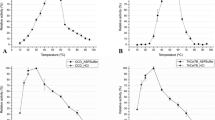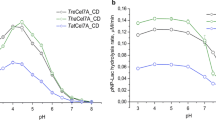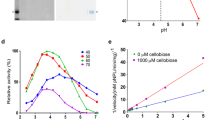Abstract
Due to its elevated cellulolytic activity, the filamentous fungus Trichoderma harzianum (T. harzianum) has considerable potential in biomass hydrolysis application. Cellulases from Trichoderma reesei have been widely used in studies of cellulose breakdown. However, cellulases from T. harzianum are less-studied enzymes that have not been characterized biophysically and biochemically as yet. Here, we examined the effects of pH and temperature on the secondary and tertiary structures, compactness, and enzymatic activity of cellobiohydrolase Cel7A from T. harzianum (Th Cel7A) using a number of biophysical and biochemical techniques. Our results show that pH and temperature perturbations affect Th Cel7A stability by two different mechanisms. Variations in pH modify protonation of the enzyme residues, directly affecting its activity, while leading to structural destabilization only at extreme pH limits. Temperature, on the other hand, has direct influence on mobility, fold, and compactness of the enzyme, causing unfolding of Th Cel7A just above the optimum temperature limit. Finally, we demonstrated that incubation with cellobiose, the product of the reaction and a competitive inhibitor, significantly increased the thermal stability of Th Cel7A. Our studies might provide insights into understanding, at a molecular level, the interplay between structure and activity of Th Cel7A at different pH and temperature conditions.






Similar content being viewed by others
References
Boer B, Koivula A (2003) The relationship between thermal stability and pH optimum studied with wild-type and mutant Trichoderma ressei cellobiohydrolase Cel7A. Eur J Biochem 270:841–848
Bommarius AS, Katona A, Cheben SE, Patel AS, Ragauskas AJ, Knudson K, Pu Y (2008) Cellulase kinetics as a function of cellulose pretreatment. Metab Eng 10(6):370–381
Boraston AB, Bolam DN, Gilbert HJ, Davies GJ (2004) Carbohydrate-binding modules: fine-tuning polysaccharide recognition. Biochem J 382:769–781
Castro AM, Pedro KC, Cruz JC, Ferreira MC, Leite SG, Pereira N (2010) Trichoderma harzianum IOC-4038: a promising strain for the production of a cellulolytic complex with significant β-glucosidase activity from sugarcane bagasse cellulignin. Appl Biochem Biotechnol 162(7):2111–2122
Colussi F, Textor LC, Serpa V, Maeda RN, Pereira N, Polikarpov I (2010) Purification, crystallization and preliminary crystallographic analysis of the catalytic domain of the extracellular cellulase CBHI from Trichoderma harzianum. Acta Crystallogr Sect F Struct Biol Cryst Commun 66:1041–1044
Colussi F, Serpa V, Delabona PS, Manzine LR, Voltatódio ML, Alves R, Mello BL, Pereira JRN, Farinas CS, Golubev AM, Santos MAM, Polikarpov I (2011) Purification, biochemical and biophysical characterization of cellobiohydrolase I from Trichoderma harzianum IOC 3844. J Microbiol Biotech 21:808–817
Darimont BD, Wagner RL, Apriletti JW, Stallcup MR, Kushner PJ, Baxter JD, Fletterick RJ, Yamamoto KR (1998) Structure and specificity of nuclear receptor-coactivator interactions. Genes Dev 12(21):3343–3356
Davies G, Henrissat B (1995) Structures and mechanisms of glycosyl hydrolases. Structure 3:853–859
Divne C, Stahlberg J, Reinikainen T, Ruohonen L, Pettersson G, Knowles JKC, Teeri TT, Jones TA (1994) The 3-dimensional crystal-structure of the catalytic core of cellobiohydrolase I from Trichoderma reesei. Science 265(5171):524–528
Doniach S, Bascle J, Garel T, Orland H (1995) Partially folded states of proteins—characterization by X-ray-scattering. J Mol Biol 254(5):960–967
Ericsson UB, Hallberg BM, DeTitta GT, Dekker N, Nordlund P (2006) Thermofluor-based high-throughput stability optimization of proteins for structural studies. Anal Biochem 357(2):289–298
Garcia W, Araújo APU, Lara F, Foguel D, Tanaka M, Tanaka T, Garratt RC (2007) An intermediate structure in the thermal unfolding of the GTPase domain of human Sept4 (SEPT4/Bradeion-β) forms amyloid-like filaments in vitro. Biochemistry 46:11101–11109
Garcia W, Figueira ACM, Oliveira Neto M, Guzzi CA, Buzzá HH, Portugal RV, Calgaro MR, Polikarpov I (2008a) Probing conformational changes in orphan nuclear receptor: the NGFI-B intermediate is a partially unfolded dimer. Biophys Chem 137:81–87
Garcia W, Rodrigues NC, Oliveira Neto M, Araújo APU, Polikarpov I, Tanaka M, Tanaka T, Garratt RC (2008b) The stability and aggregation properties of the GTPase domain from human SEPT4. Biochim Biophys Acta 1784:1720–1727
Gill SC, von Hippel PH (1989) Calculation of protein extinction coefficients from amino acid sequence data. Anal Biochem 182:319–326
Grassick A, Murray PG, Thompson R, Collins CM, Byrnes L, Birrane G, Higgins TM, Tuohy MG (2004) Three-dimensional structure of a thermostable native cellobiohydrolase, CBH IB, and molecular characterization of the cel7 gene from the filamentous fungus, Talaromyces emersonii. Eur J Biochem 271(22):4495–4506
Gray KA, Zhao LS, Emptage M (2006) Bioethanol. Curr Opin Chem Biol 10(2):141–146
Henrissat B, Davies G (1997) Structural and sequence-based classification of glycoside hydrolases. Curr Opin Chem Biol 7(5):637–644
Hui JPM, White TC, Thibault P (2002) Identification of glycan structure and glycosylation sites in cellobiohydrolase II and endoglucanases I and II from Trichoderma reesei. Glycobiology 12(12):837–849
Igarashi K, Wada M, Hori R, Samejima M (2006) Surface density of cellobiohydrolase on crystalline celluloses—a critical parameter to evaluate enzymatic kinetics at a solid-liquid interface. FEBS J 273(13):2869–2878
Kellermann G, Vicentin F, Tamura E, Rocha M, Tolentino H, Barbosa A, Craievich A, Torriani I (1997) The small-angle X-ray scattering beamline of the Brazilian Synchrotron Light Laboratory. J Appl Crystallogr 30(2):880–883
Kleywegt GJ, Zou JY, Divne C, Davies GJ, Sinning I, Stahlberg J, Reinikainen T, Srisodsuk M, Teeri TT, Jones TA (1997) The crystal structure of the catalytic core domain of endoglucanase I from Trichoderma reesei at 3.6 angstrom resolution, and a comparison with related enzymes. J Mol Biol 272(3):383–397
Kubicek CP, Messner R, Gruber F, Mach RL, Kubicekpranz EM (1993) The Trichoderma cellulase regulatory puzzle—from the interior life of a secretory fungus. Enzyme Micro Technol 15(2):90–99
Kumar R, Singh S, Singh OV (2008) Bioconversion of lignocellulosic biomass: biochemical and molecular perspectives. J Ind Microbiol Biotechnol 35:377–391
Munoz IG, Ubhayasekera W, Henriksson H, Szabo I, Pettersson G, Johansson G, Mowbray SL, Stahlberg J (2001) Family 7 cellobiohydrolases from Phanerochaete chrysosporium: crystal structure of the catalytic module of Cel7D (CBH58) at 1.32 angstrom resolution and homology models of the isozymes. J Mol Biol 314(5):1097–1111
Parkkinen T, Koivula A, Vehmaanpera J, Rouvinen J (2007) Preliminary X-ray analysis of cellobiohydrolase Cel7B from Melanocarpus albomyces. Acta Crystallogr Sect F Struct Biol Cryst Commun 63:754–757
Semisotnov GV, Kihara H, Kotova NV, Kimura K, Amemiya Y, Wakabayashi K, Serdyuk IN, Timchenko AA, Chiba K, Nikaido K et al (1996) Protein globularization during folding. A study by synchrotron small-angle X-ray scattering. J Mol Biol 262(4):559–574
Shen H, Schmuck M, Pilz I, Gilkes NR, Kilburn DG, Miller RC, Warren RAJ (1991) Deletion of the linker connecting the catalytic and cellulose-binding domains of endoglucanase-A (CENA) of cellulomonas-fimi alters its conformation and catalytic activity. J Biol Chem 266(17):11335–11340
Srisodsuk M, Reinikainen T, Penttila M, Teeri TT (1993) Role of the interdomain linker peptide of Trichoderma reesei cellobiohydrolase I in its interaction with the crystalline cellulose. J Biol Chem 268(28):20756–20761
Teeri TT (1997) Crystalline cellulose degradation: new insight into the function of cellobiohydrolases. Trends Biotechnol 15:160–167
von Ossowski I, Stahlberg J, Koivula A, Piens K, Becker D, Boer H, Harle R, Harris M, Divne C, Mahdi S et al (2003) Engineering the exo-loop of Trichoderma reesei cellobiohydrolase, Ce17A. A comparison with Phanerochaete chrysosporium Cel7D. J Mol Biol 333(4):817–829
Voutilainen SP, Boer H, Alapuranen M, Jänis J, Vehmaanperä J, Koivula A (2009) Improving the thermostability and activity of Melanocarpus albomyces cellobiohydrolase Cel7B. Appl Microbiol Biotechnol 83:261–272
Wood TM, Bhat KM (1988) Methods for measuring cellulase activities. Methods Enzymol 160:87–112
Acknowledgments
This work was supported by Fundação de Amparo à Pesquisa do Estado de São Paulo (FAPESP) via grant numbers 2008/56255-9, 2009/54035-4, 2010/08370-3, 2010/16542-9; Conselho Nacional de Desenvolvimento Científico e Tecnológico (CNPq) via grant number 482166/2010-0; and Coordenação de Aperfeiçoamento de Pessoal de Nível Superior (CAPES). We also thank Laboratório Nacional de Luz Sincrotron (LNLS) for beam time and help with X-ray data collection.
Author information
Authors and Affiliations
Corresponding author
Additional information
Francieli Colussi and Wanius Garcia contributed equally to this work.
Rights and permissions
About this article
Cite this article
Colussi, F., Garcia, W., Rosseto, F.R. et al. Effect of pH and temperature on the global compactness, structure, and activity of cellobiohydrolase Cel7A from Trichoderma harzianum . Eur Biophys J 41, 89–98 (2012). https://doi.org/10.1007/s00249-011-0762-8
Received:
Revised:
Accepted:
Published:
Issue Date:
DOI: https://doi.org/10.1007/s00249-011-0762-8




